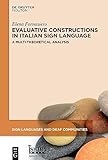Evaluative Constructions in Italian Sign Language (LIS) : A Multi-Theoretical Analysis / Elena Fornasiero.
Material type: TextSeries: Sign Languages and Deaf Communities [SLDC] ; 17Publisher: Berlin ; Boston : De Gruyter Mouton, [2023]Copyright date: ©2023Description: 1 online resource (XIX, 223 p.)Content type:
TextSeries: Sign Languages and Deaf Communities [SLDC] ; 17Publisher: Berlin ; Boston : De Gruyter Mouton, [2023]Copyright date: ©2023Description: 1 online resource (XIX, 223 p.)Content type: - 9783110783391
- 9783110783506
- 9783110783445
- 419.45059
- online - DeGruyter
- Issued also in print.
| Item type | Current library | Call number | URL | Status | Notes | Barcode | |
|---|---|---|---|---|---|---|---|
 eBook
eBook
|
Biblioteca "Angelicum" Pont. Univ. S.Tommaso d'Aquino Nuvola online | online - DeGruyter (Browse shelf(Opens below)) | Online access | Not for loan (Accesso limitato) | Accesso per gli utenti autorizzati / Access for authorized users | (dgr)9783110783445 |
Browsing Biblioteca "Angelicum" Pont. Univ. S.Tommaso d'Aquino shelves, Shelving location: Nuvola online Close shelf browser (Hides shelf browser)
PhD Università Ca' Foscari Venice 2020.
Frontmatter -- Acknowledgements -- Contents -- List of tables -- List of figures -- Notational conventions -- Sign language acronyms -- List of abbreviations -- Introduction -- Part I: Theoretical background -- 1 Investigating evaluative morphology from different perspectives -- 2 Morphophonological aspects of sign languages -- Part II: Methodological issues -- 3 Methodology -- Part III: Evaluative constructions in Italian Sign Language -- 4 Descriptive analysis of LIS evaluative constructions -- 5 Formal analysis of LIS evaluative constructions -- Conclusions -- Appendix A1: Object description task -- Appendix A2: Narration task -- Appendix A3: Object description task for SASSes elicitation -- References -- Index
restricted access online access with authorization star
http://purl.org/coar/access_right/c_16ec
The domain of evaluative morphology is vast and complex, as it requires the combination of morphological, semantic and pragmatic information to be understood. Nevertheless, cross-linguistic studies on spoken languages show that languages share some patterns in the way they encode evaluative features. It follows that investigating evaluative morphology in sign languages (SLs) can enrich the literature and offer new insights. This book provides descriptive and theoretical contributions by considering Italian Sign Language (LIS) as empirical ground of investigation. At the descriptive level, the analysis of corpus and elicited data improves the description of morphological processes in LIS, as well as typological studies on evaluative morphology by adding the patterns of a visuo-gestural language. At the theoretical level, the study shows the benefit of combining different approaches (Generative Linguistics, Linguistic Typology, Cognitive Linguistics) for the exploration of evaluative constructions in SLs, as it allows to identify both modality-specific and modality-independent properties.In sum, this book encourages the readers to rely on different data types, analyses and theoretical perspectives to investigate linguistic phenomena in SLs.
Issued also in print.
Mode of access: Internet via World Wide Web.
In English.
Description based on online resource; title from PDF title page (publisher's Web site, viewed 25. Jun 2024)









